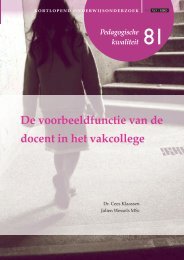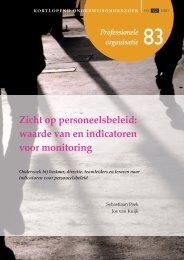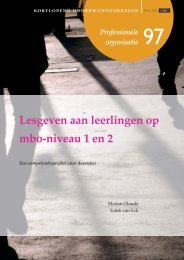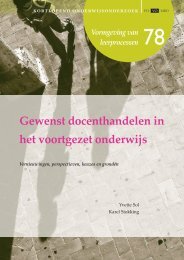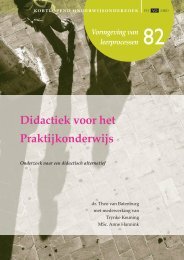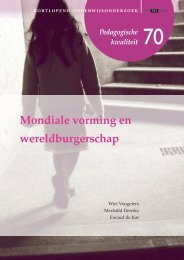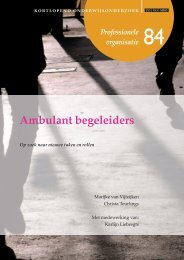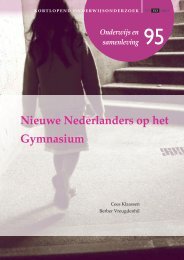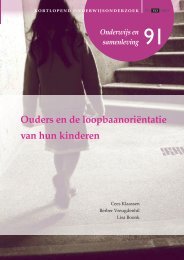Proud to be tvmbo - Kortlopend Onderwijsonderzoek
Proud to be tvmbo - Kortlopend Onderwijsonderzoek
Proud to be tvmbo - Kortlopend Onderwijsonderzoek
Create successful ePaper yourself
Turn your PDF publications into a flip-book with our unique Google optimized e-Paper software.
Time<br />
Speak slowly <strong>to</strong> your students, use short sentences and, in the <strong>be</strong>ginning, avoid idioms.<br />
When you ask questions, give enough thinking time <strong>to</strong> the students, since they not<br />
only have <strong>to</strong> process the <strong>to</strong>pic but also the language <strong>to</strong> talk about the <strong>to</strong>pic (Wragg &<br />
Brown, 2001). Wait at least seven seconds after you ask a question <strong>be</strong>fore you ask for<br />
an answer. Use the “no hands” rule: everyone has <strong>to</strong> think, no-one puts their hand up<br />
and anyone might <strong>be</strong> called upon <strong>to</strong> give an answer.<br />
Connect <strong>to</strong> real life<br />
Activate learners’ prior knowledge about the <strong>to</strong>pic and also remem<strong>be</strong>r <strong>to</strong> activate what<br />
language they already know about it. Relate <strong>to</strong>pics you are learning about <strong>to</strong> their real<br />
lives: <strong>to</strong> video clips, <strong>to</strong> events in the news, <strong>to</strong> their families and friends.<br />
Concrete materials<br />
Use concrete materials in your lessons, for example physical models, flashcards and<br />
drawings. Use object and do and create things with your students, rather than only talk<br />
about them. These students learn <strong>be</strong>st with a lot of visual and hands on support, such<br />
as pictures and games. Use your own body and facial gestures a lot. Make your lessons<br />
as visible as possible, using posters, notes, graphic organizers, and the board. Supply<br />
learners with lots of different input: texts, video, spoken information from you. Use<br />
frequent physical activity - movement and gesture; get your students moving!<br />
Comprehensible input<br />
Select a variety of materials related <strong>to</strong> your <strong>to</strong>pics at an appropriate level: this means<br />
<strong>be</strong>ing aware of the language level of your students. Look at the level of language it is,<br />
for example by using the Common European Framework of Reference (CEFR) for<br />
languages: for instance, if the learners in the first year at A1 or A2 level on the CEFR,<br />
tasks and texts need <strong>to</strong> <strong>be</strong> at A1 or A2 level, or just above.<br />
Reading and listening<br />
If learners are listening or reading, give them a concrete task <strong>to</strong> help them <strong>to</strong> understand<br />
the input. Use scaffolding (see glossary) and appropriate questions at a variety of<br />
levels of complexity (Wragg & Brown, 2001). As well as discussing the subject, pay<br />
attention <strong>to</strong> learning the language related <strong>to</strong> your <strong>to</strong>pic. When reading or listening,<br />
provide short tasks or games <strong>to</strong> help understanding. Invent active reading tasks, where<br />
students engage with the text they are reading or listening <strong>to</strong>. Provide tasks initially for<br />
general understanding and then for more specific understanding of more specific information.<br />
Remem<strong>be</strong>r <strong>to</strong> recycle information with varied input – through texts and<br />
38




